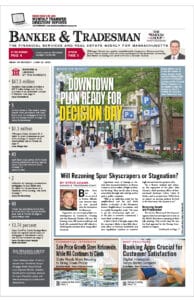
State Housing Secretary Ed Augustus speaks to reporters at the State House on Feb. 6, 2025 as Gov. Maura Healey, second from left, and members of the state Housing Advisory Council listen. Photo by James Sanna | Banker & Tradesman Staff
The MBTA Communities law is just the starting point.
That’s the message in the Healey administration’s comprehensive housing plan, which concludes Massachusetts communities need to further expand multifamily zoning to reach a goal of building 222,000 more housing units by 2035 to meet demand.
“Building these housing units is going to help us bring down costs and keep our economy competitive,” Gov. Maura Healey told reporters at a State House event to announce the new plan Thursday morning.If you’ve had to wait in an emergency room, welcome to the housing crisis.
The plan was the product of both state officials and a commission of top real estate, housing and municipal leaders, plus listening sessions conducted around the state. State officials said over 3,000 people offered testimony, ideas and survey responses during the year-long process.
“We heard from a young municipal employee born raised and now working for his hometown of Marblehead. He can’t afford to rent a home, let alone purchase one,” said state Housing Secretary Ed Augustus. “We heard from a housing case manager whose job is it is to help people experiencing homelessness find housing. They pay nearly 60 percent of their monthly income on rent and live with the constant fear that they are one emergency away from becoming homeless themselves.”
Healey Looks to State-Owned Land
One potential source of high-impact development sites is emerging in state surplus properties, administration officials said in a briefing prior to the report’s unveiling. The state’s real estate agency, the Division of Capital Asset Management and Maintenance, has identified approximately 100 properties that will be offered to housing developers beginning this year.
Gov. Maura Healey issued an executive order in 2023 for state agencies to submit data to DCAMM and EOHLC on underutilized publicly-owned properties that could be redeveloped as housing.
Officials have identified approximately 100 sites that could be redeveloped, with capacity to build nearly 10,000 housing units over the next five years, according to the report.
An announcement on the first disposition is expected within weeks, administration officials said.
The MBTA already is preparing to offer a new set of its own properties for major developments including housing.
Last August, the transit agency sought letters of interest from developers to demolish and rebuild the Alewife garage in Cambridge for a mixed-use development. The MBTA also has approached Woburn officials about a mixed-use development at the 34-acre Anderson Regional Transportation Center property.

Image courtesy of Executive Office of Housing and Livable Communities
Backs Away from ‘Top-Down Approach’
The administration’s plan spotlights changing demographics and a mismatch between the state’s existing housing stock and changing population trends, including demand for smaller housing units by aging adults and young singles.
That points to the need for additional multifamily construction, with the largest increase in housing units needed in eastern Massachusetts, it states.
The report by the state Executive Office of Housing and Livable Communities stops short of recommending more state mandates for local housing production.
“A top-down approach will not be successful in achieving the state’s need for more housing as it requires collective efforts across municipalities and entities that encompass our housing ecosystem,” the report states.
The MBTA Communities law enacted in 2021 required 177 cities and towns to enact zoning laws for multifamily housing construction near transit stops. To date, 119 communities have approved rezoning plans, including some that could encourage development of thousands of new units.
“Even after full adoption of the law, additional capacity will likely be needed in some communities and regions to enable housing abundance,” the report states.
Additional Policy Proposals Coming
Speaking at the report’s unveiling, Healey and Augustus made clear they plan to “work with” communities that have been resistant to adding more housing, including through MBTA Communities law rezonings.
The report’s data – Healey, Augustus and members of the committee frequently noted how it was Massachusetts’ first statewide housing plan – they said, would hopefully help persuade voters and officials to approve more individual housing developments and new zoning to enable housing development.
“[This report] is facts, is demographic trends that hopefully inform the debate, so that we get a lot more light and maybe a little less heat during local housing debates,” Augustus said. “So that we’re using facts, and we’re using objective information, to make decisions that we need to make to take the pressure off this crisis.”
Developer Stephen Davis, president of Boston-based The Davis Companies and a member of the commission that produced the new plan, said the economic necessity of building more housing gave him hope that communities could be trusted to plan for more housing.
“There’s a better incentive structure in place, now. There’s better messaging, too,” he said.
Augustus also promised additional, more detailed plans in the coming weeks from a separate blue-ribbon commission that could offer more forceful policy fixes.
“Some of the strategies outlined here, we’ve already put in place, but there are new doors for us to open. And shortly, we’ll have the Commission on Unlocking Housing Production report that will make a host of additional proposals,” he said.
EOHLC collaborated with Metropolitan Area Planning Council, the University of Massachusetts Donahue Institute and Dain Research on the analysis of existing housing and future needs.
Editor’s note: This story has been updated with quotes and information from the plan’s announcement press conference.








